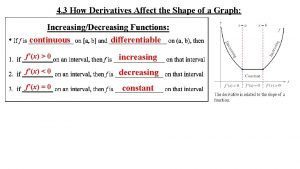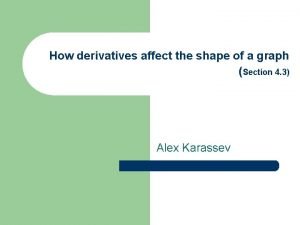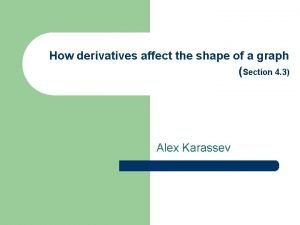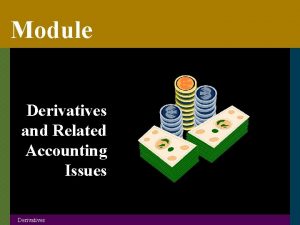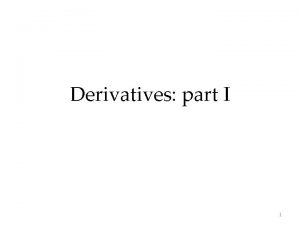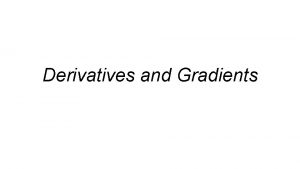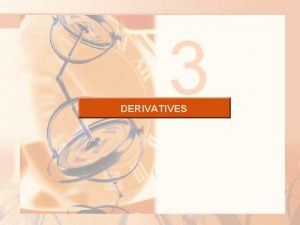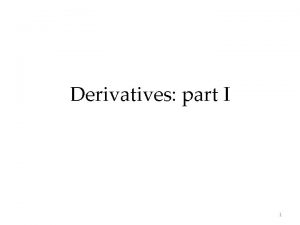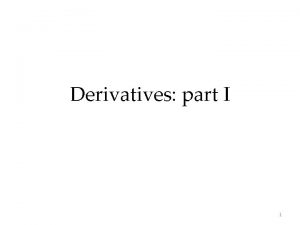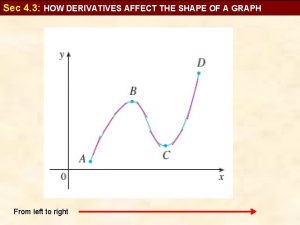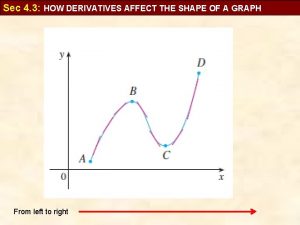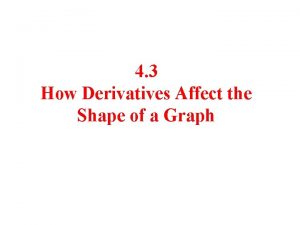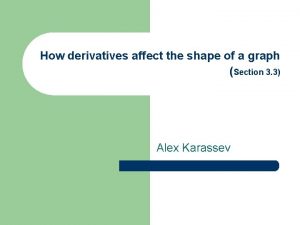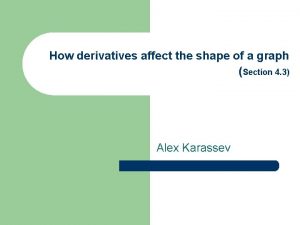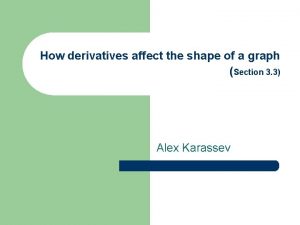4 3 How Derivatives Affect the Shape of
















- Slides: 16

4. 3 How Derivatives Affect the Shape of a Graph: continuous differentiable f’(x) > 0 increasing f’(x) < 0 decreasing f’(x) = 0 constant

First find f’ and set = 0. Test the intervals around the critical values. Increase x<0 Decrease 0<x<1 Increase x>1 Short cut. Right Hand Behavior is always the same as the sign of the leading term of f’ and signs alternate to the left as long as each x-intercept is in numerical order and occurs an odd number of times. Even occurrences keeps the signs the same.

First find f’ and set = 0. Short cut. Right Hand Behavior is positive. x-int (3/2, 0) occurs once, so signs Decreasing interval. Increasing interval. alternate. x-int (0, 0) occurs twice, so signs DO NOT alternate. monotonic function a function that ALWAYS increases or ALWAYS decreases

The First Derivative Test: * if c is a critical # of f, + to – , then f has a relative _______ maximum 1. if f’ changes from ____ at c – to + minimum 2. if f’ changes from _____, then f has a relative _______ at c 3. if ____ no sign change, ___ no max or min

EX #2: Find the relative extrema. a. ) look back at EX #1 a… x = 0 is a max, + to – Local max at (0, 0) x = 1 is a min, – to + Local min at (1, -0. 5) b. ) look back at EX #1 b… x = 0 has no x = 3/2 is a min, sign change, – to + no max or min Local min at (3/2, -27/16)

EX #2: Find the relative extrema. Local min at Local max at Local min at

EX #3: a. ) On what intervals is f increasing? Decreasing? f’(x) > 0…Increasing interval. f’(x) < 0…Decreasing interval. b. ) At what values of x does f have local extrema? At x = 1, + to – Local max. At x = 5, – to + Local min. At x = 7, + to – Local max.

NOW, we are going to discuss where functions are curving upward or downward Concavity: * concave up * concave down Concavity Test: * if f is a function whose 2 nd derivative exists on an open interval, upward f ” (x) > 0 then the graph of f is concave _____ 1. if _____, f ” (x) < 0 then the graph of f is concave ______ 2. if _____, downward

Points of Inflection: where the graph changes concavity f ” (x) = 0 or f ”(x) _____ DNE * possible points of inflection are where ______ (as long as x is in the domain; ex: vertical asymptotes in any f / f ’ / f ”)

First find f’ and f ”. f is continuous. Points of Inflection (0, 0) and (2, -16) Local min at (3, -27) Concave UP DOWN Points of Inflection are at (0, 0) and (2, -16). f (x) will concave up to the left of (0, 0) and to the right of (2, -16). The graph will concave down between the inflection points

First find f’ and f ”. f is continuous. Concave UP Concave DOWN Concave UP

EX #5: Determine the intervals on which the graph is concave upward or downward. First find f’ and f ”. f is continuous. No points of inflection. Use the vert. asymptotes as boundaries to determine test points for concavity. Concave UP Concave DOWN Concave UP

2 nd Derivative Test: f’ (c) = 0 and _____, f ” (c) > 0 then f has a relative _______ min at x = c 1. if _____ f’ (c) = 0 and _____, f ” (c) < 0 then f has a relative _______ 2. if _____ max at x = c Relative min No extrema Relative max No extrema Relative min

Graphs: EX #7: Sketch the graph w/the given characteristics… f(0) = f(2) = 0 x-int at (0, 0) & (2, 0) f’(x) < 0 if x < 1 Decreasing left of x = 1 f’(1) = 0 Relative extrema at x = 1 f’(x) > 0 if x > 1 Increasing right of x = 1 f ”(1) > 0 Relative min at x = 1


 How derivatives affect the shape of a graph
How derivatives affect the shape of a graph How derivatives affect the shape of a graph
How derivatives affect the shape of a graph How derivatives affect the shape of a graph
How derivatives affect the shape of a graph Shape matching and object recognition using shape contexts
Shape matching and object recognition using shape contexts Template matching
Template matching Airfoil nomenclature
Airfoil nomenclature Lời thề hippocrates
Lời thề hippocrates Chụp tư thế worms-breton
Chụp tư thế worms-breton đại từ thay thế
đại từ thay thế Quá trình desamine hóa có thể tạo ra
Quá trình desamine hóa có thể tạo ra Cong thức tính động năng
Cong thức tính động năng Thế nào là mạng điện lắp đặt kiểu nổi
Thế nào là mạng điện lắp đặt kiểu nổi Sự nuôi và dạy con của hươu
Sự nuôi và dạy con của hươu Dot
Dot Biện pháp chống mỏi cơ
Biện pháp chống mỏi cơ Bổ thể
Bổ thể Vẽ hình chiếu đứng bằng cạnh của vật thể
Vẽ hình chiếu đứng bằng cạnh của vật thể
